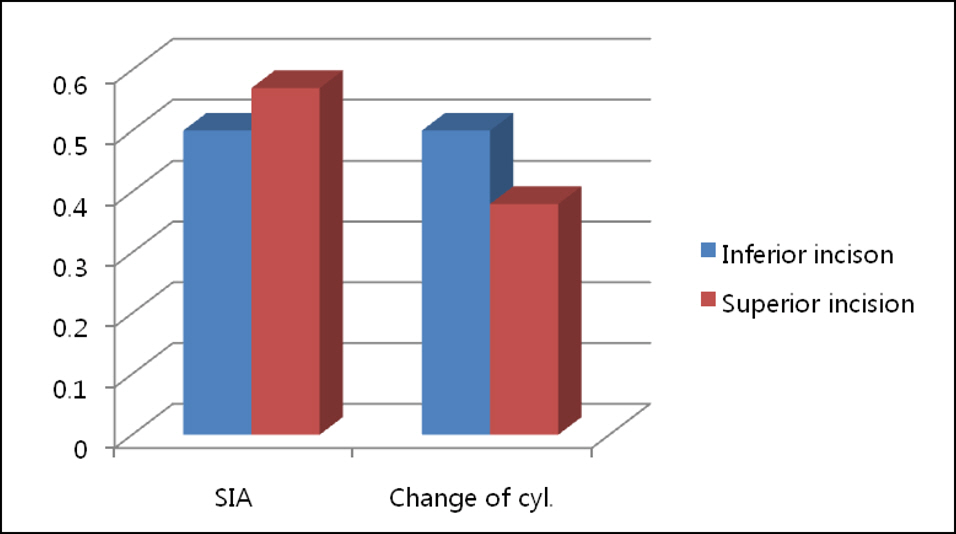J Korean Ophthalmol Soc.
2014 Oct;55(10):1470-1475. 10.3341/jkos.2014.55.10.1470.
The Comparison of Astigmatic Outcomes after Cataract Surgery of Inferior versus Superior Clear Corneal Incision
- Affiliations
-
- 1Department of Ophthalmology and Visual Science, Seoul St. Mary's Hospital, The Catholic University of Korea College of Medicine, Seoul, Korea. mskim@catholic.ac.kr
- KMID: 2216864
- DOI: http://doi.org/10.3341/jkos.2014.55.10.1470
Abstract
- PURPOSE
To analyze the difference in astigmatism and the mean change in total astigmatism between inferior clear corneal incision and superior clear corneal incision following cataract surgery in surgically-induced astigmatism (SIA).
METHODS
Fifty-five eyes of 55 patients with with-the-rule astigmatism >0.5 diopters were evaluated. Patients were divided into two groups according to incision location (Group 1, 26 eyes with an inferior incision; Group 2, 29 eyes with a superior incision). Patients were evaluatied one month postoperatively. Uncorrected visual acuity (UCVA, log MAR), best-corrected visual acuity (BCVA, log MAR), SIA and mean change in corneal astigmatism were measured in both groups.
RESULTS
One month postoperatively, mean UCVA was 0.15 +/- 0.17 log MAR in Group 1 and 0.23 +/- 0.24 log MAR in Group 2 (p = 0.253). Mean BCVA was 0.08 +/- 0.13 and 0.08 +/- 0.12 log MAR in Groups 1 and 2, respectively (p = 0.926). The SIA was 0.50 +/- 0.17 diopter and 0.57 +/- 0.34 diopter (p = 0.253) and mean change in total astigmatism was 0.50 +/- 0.96 diopter and 0.38 +/- 0.86 diopter in Groups 1 and 2, respectively (p = 0.426).
CONCLUSIONS
There was no statistically significant difference between the two groups. Thus, corneal incision on the inferior side in patients of with-the-rule astigmatism can reduce the SIA and mean change in corneal astigmatism for patients with glaucoma, hard upper eyelid tension or sunken eye.
Keyword
Figure
Cited by 1 articles
-
Intraocular Lens Power Calculations Using Dual Scheimpflug Analyzer
Young Bok Lee, Ka Young Yi, So Hyun Bae, Ha Kyoung Kim, Joon Young Hyon, Won Ryang Wee, Young Joo Shin
J Korean Ophthalmol Soc. 2016;57(3):369-379. doi: 10.3341/jkos.2016.57.3.369.
Reference
-
References
1. Tejedor J, Murube J. Choosing the location of corneal incision based on preexisting astigmatism in phacoemulsification. Am J Ophthalmol. 2005; 139:767–76.
Article2. Khokhar S, Lohiya P, Murugiesan V, Panda A. Corneal astigmatism correction with opposite clear corneal incisions or single clear corneal incision: comparative analysis. J Cataract Refract Surg. 2006; 32:1432–7.
Article3. Bayramlar H, Hü Dağlioğlu MC, Borazan M. Limbal relaxing incisions for primary mixed astigmatism and mixed astigmatism after cataract surgery. J Cataract Refract Surg. 2003; 29:723–8.
Article4. Barequet IS, Yu E, Vitale S, et al. Astigmatism outcomes of horizontal temporal versus nasal clear corneal incision cataract surgery. J Cataract Refract Surg. 2004; 30:418–23.
Article5. Kaufmann C, Peter J, Ooi K, et al. Limbal relaxing incisions versus on-axis incisions to reduce corneal astigmatism at the time of cataract surgery. J Cataract Refract Surg. 2005; 31:2261–5.
Article6. Wang Li, Misra M, Koch DD. Peripheral corneal relaxing incisions combined with cataract surgery. J Cataract Refract Surg. 2003; 29:712–22.
Article7. Seo JB, Joo CK. Long-term course of induced astigmatism after temporal clear corneal incision in cataract surgery. J Korean Ophthalmol Soc. 1999; 40:3038–43.8. Shepherd JR. Induced astigmatism in small incision cataract surgery. J Cataract Refract Surg. 1989; 15:85–8.
Article9. Cravy TV. Routine use of a lateral approach to cataract extraction to achieve rapid and sustained stabilization of postoperative astigmatism. J Cataract Refract Surg. 1991; 17:415–23.
Article10. Vasavada A, Singh R. Relationship between lens and capsular bag size. J Cataract Refract Surg. 1998; 24:547–51.
Article11. Axt JC, McCaffery JM. Reduction of postoperative against-the-rule astigmatism by lateral incision technique. J Cataract Refract Surg. 1993; 19:380–6.
Article12. Brint SF. Refractive cataract surgery. Int Ophthalmol Clin. 1994; 34:1–11.
Article13. Koch PS. Mastering phacoemulsification: A simplified manual of strategies for the spring, crack, and stop & chop technique. 4th ed.Thorofare, NJ: Slack;1994; 7–44.14. Lindstrom RL. Cataract surgery and lens implantation. Curr Opin Ophthalmol. 1994; 5:1–4.
Article15. Axt JC, McCaffery JM. Reduction of postoperative against-the-rule astigmatism by lateral incision technique. J Cataract Refract Surg. 1993; 19:380–6.
Article16. Mendívil A. Comparative study of astigmatism through superior and lateral small incisions. Eur J Ophthalmol. 1996; 6:389–92.
Article17. Roman S, Ullern M. [Astigmatism caused by superior and temporal corneal incisions in cataract surgery]. J Fr Ophtalmol. 1997; 20:277–83.18. Joo CK, Han HK, Kim JH. Computer-assisted videokeratography to measure changes in astigmatism induced by sutureless cataract surgery. J Cataract Refract Surg. 1997; 23:555–61.
Article19. Simşek S, Yaşar T, Demirok A, et al. Effect of superior and temporal clear corneal incisions on astigmatism after sutureless phacoe-mulsification. J Cataract Refract Surg. 1998; 24:515–8.20. Roman SJ, Auclin FX, Chong-Sit DA, Ullern MM. Surgically induced astigmatism with superior and temporal incisions in cases of with-the-rule preoperative astigmatism. J Cataract Refract Surg. 1998; 24:1636–41.
Article
- Full Text Links
- Actions
-
Cited
- CITED
-
- Close
- Share
- Similar articles
-
- Correction of with-the-rule Astigmatism by Superior Clear Corneal Incision and Transverse Keratotomy in Cataract Surgery
- The Location of Scleral Incision for Decrease of corneal Astigmatism in Sutureless Cataract Surgery
- Corneal Astigmatic Changes by Temporal Incision or Oblique Incision in Sutureless Cataract Surgery
- Comparison of Astigmatism According to Incision Location in 3.2mm Scleral Tunnel Incision Cataract Surgery
- Corneal Astigmatic Change after 3.2mm Temporal Clear Corneal Incision in Cataract Surgery: Comparative Study with 3.2mm Superior Scleral Incision



